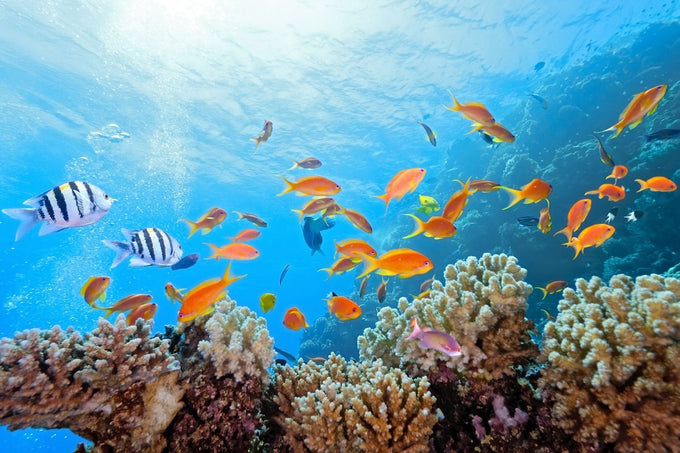What Makes a Sunscreen “Reef-Safe”?

According to the UN Environment Program, Our coral reefs are dying at an alarming rate. Like how the shrinking of the Amazon rainforest impacts the land, the loss of reefs impacts our oceans.
Much of marine life is dependent on reefs for food and shelter. Humans also rely on coral as a source of food and cutting-edge medications.
Our world needs healthy coral reefs to survive.
Why Are Our Coral Reefs Dying?
A major contributor to the destruction of reefs is sunscreen. The active chemicals in many sunscreens, oxybenzone and octinoxate, are harmful to coral. Those chemicals can be found in over 3,500 sunscreen products.
Oxybenzone and octinoxate are used in sunscreens to absorb UV rays. While they do a good job of protecting us from the sun, they wreak havoc on reefs. Exposure leads to the bleaching of coral and its eventual death.
Each year, an estimated 25 to 60 million bottles of sunscreen wash off into our oceans. 25% of sunscreen applied is released into the water within 20 minutes of submersion. We might as well be dumping chemicals directly into our oceans.
Sunscreen chemicals are impacting reefs so dramatically, that some products have been banned in Hawaii, Key West – Florida, and the U.S. Virgin Islands.
Learn more about sunscreen’s role in the loss of coral reefs in this video.
There are alternative sunscreens that are much more environmentally friendly. Physical sunscreens that use the minerals titanium dioxide and zinc oxide, instead of chemicals, are safer for marine life.
What Sunscreen Is Reef-Safe?
On top of choosing a mineral sunscreen, there are several other factors that can make a sunscreen better for the oceans. Here are some tips on finding a reef-safe sunscreen:
- Use mineral sunscreens with “non-nanotized” zinc oxide or titanium dioxide. The larger particles are safer.
- Avoid parabens. These preservatives are harmful.
- Avoid petrolatum, commonly known as mineral oil, as it takes years to biodegrade.
- Use sunscreens with lower levels of titanium dioxide. It also takes a long time to biodegrade.
- Use “water-resistant” sunscreens so less washes off while swimming.
The toughest thing is that “Reef-Safe” is not a government-regulated term. It is a marketing term that can mean very different things to different companies. As a consumer, it is important to read sunscreen labels.
How to Reduce Sunscreen Use in Our Oceans
One of the easiest ways to reduce sunscreen in our oceans is to use less while staying sun-safe. The key is proper coverage using UPF 50+ clothing. Cover what you can and use sunscreen on what is left exposed.
Oceans account for 70% of our planet’s surface. What happens in those waters affects everything. Little changes, like choosing the right sunscreen, can add up to a big difference.
For more information on the health of our coral reefs, Netflix has a great documentary called Chasing Coral. Here is the trailer:
Keep reefs vibrant by choosing UPF swimwear and clothing from UV Skinz.






